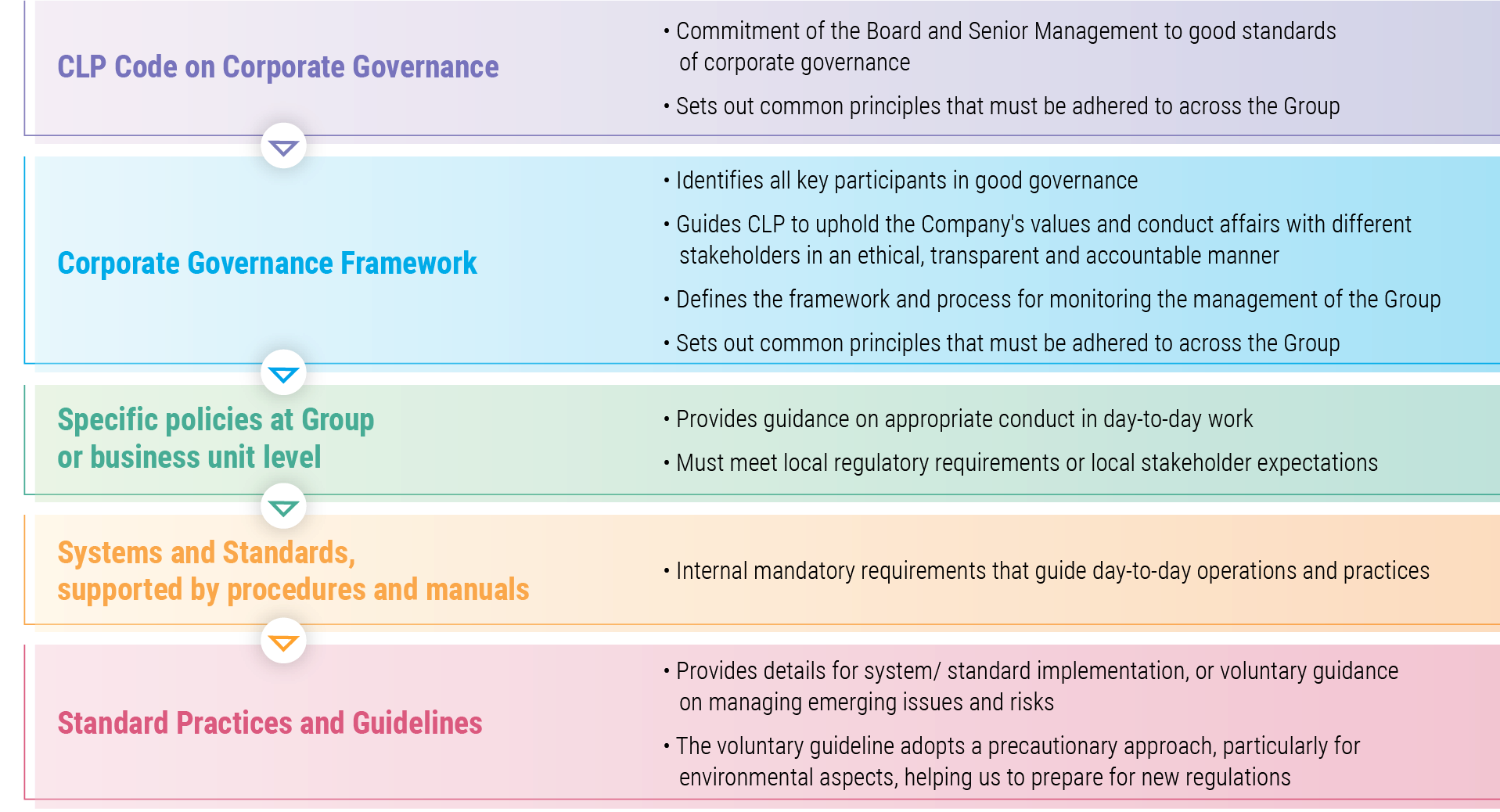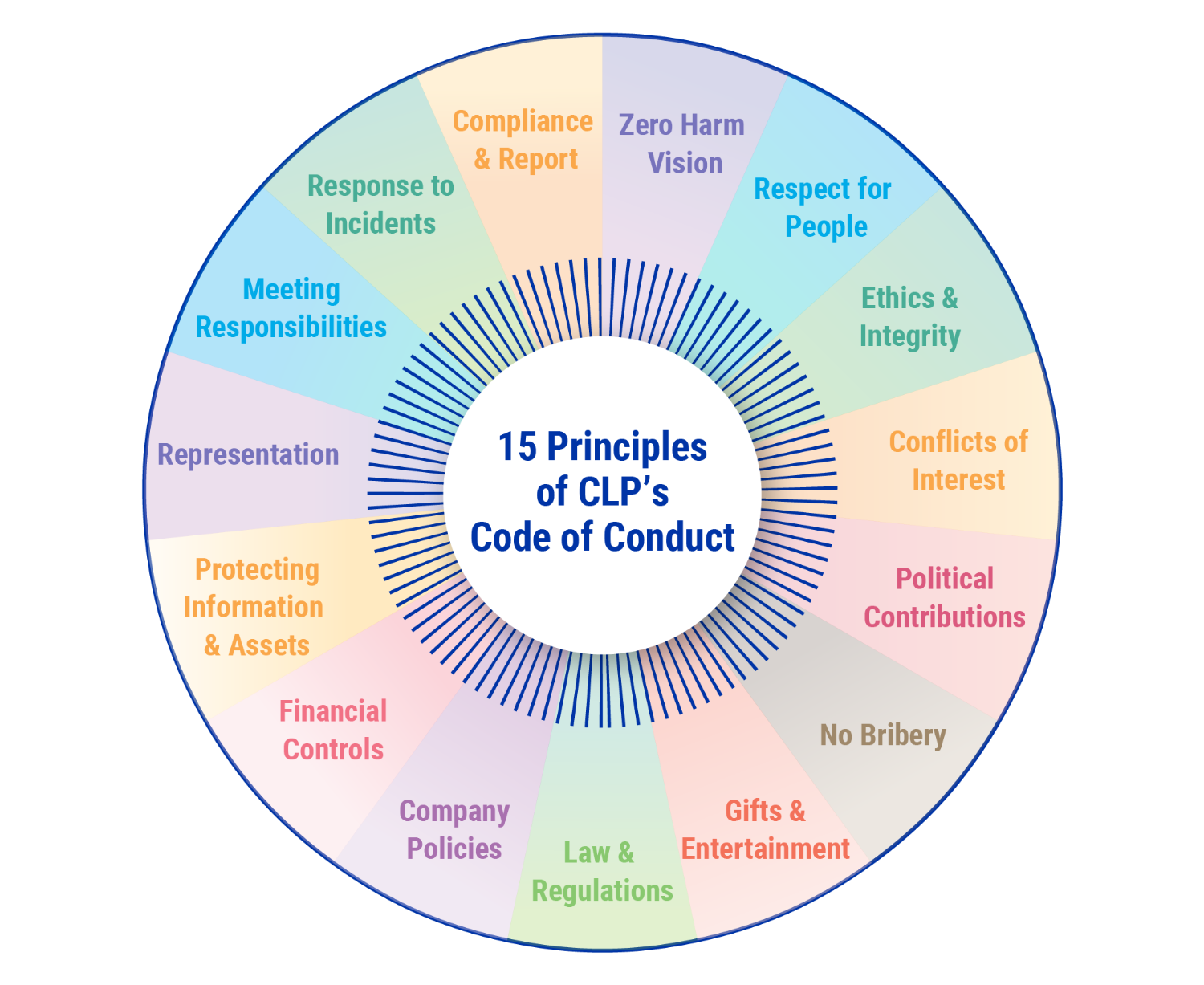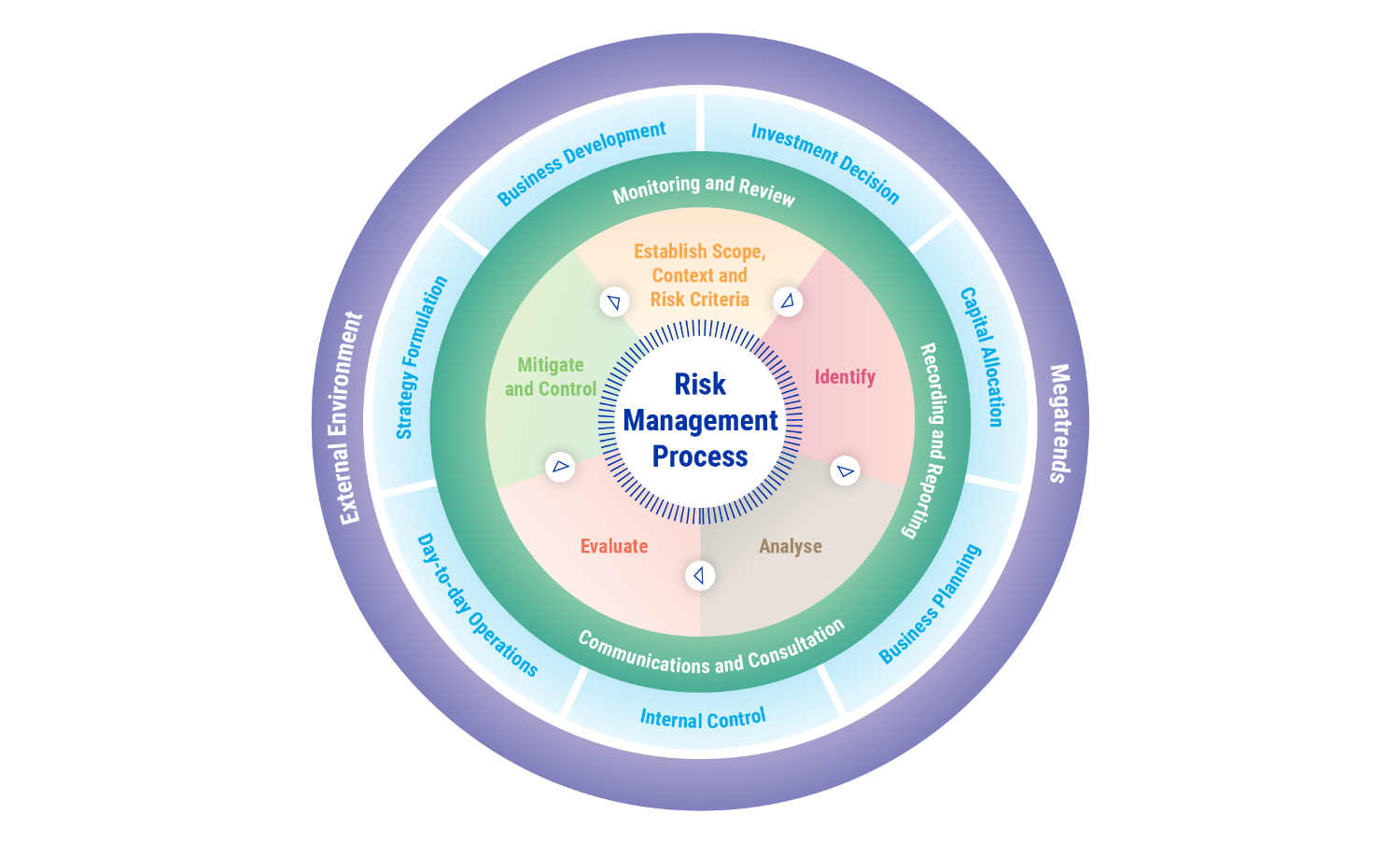Corporate governance
Code of Conduct and anti-corruption
Code of Conduct | 2021 | 2020 | 2019 | 2018 | 2017 |
|---|---|---|---|---|---|
Total number of breaches of Code of Conduct reported to the Audit & Risk Committee (cases) | 18 | 25 | 31 | 20 | 28 |
Anti-corruption | 2021 | 2020 | 2019 | 2018 | 2017 |
|---|---|---|---|---|---|
Convicted cases of corruption reported to the Audit & Risk Committee (cases) | 0 | 0 | 0 | 0 | 0 |
The 2021 data shaded in orange has been independently verified by PricewaterhouseCoopers. The assurance scope of past years' data can be found in previous Sustainability Reports.
Overview
Copy linkCopied link
Good corporate governance, anti-corruption, compliance with regulations and risk management form the bedrock of a sustainable business and underlie long-term success.
CLP successfully weathered the disruption and change brought about by the COVID-19 pandemic and provided effective support to the community, thanks in part to a strong culture of operational excellence and care for its people and communities. Robust risk management and crisis management processes also enabled the Company to use learnings from past experiences to perform at the level required during such challenging times.
To protect this bedrock, the Group continuously strives to embed good corporate governance practices in its day-to-day operations, in pursuing its vision and by implementing CLP's Value Framework .
Corporate governance framework and code
Copy linkCopied link
GRI reference: 2-15, 2-23, 2-24
Corporate governance is a matter of culture, driving CLP to continually make conscious decisions around correct behaviours. Over the years, the Company has developed and put in place a Code on Corporate Governance, Corporate Governance Framework, and comprehensive set of procedures, systems, policies and guidelines that make up the unique CLP corporate governance structure.
Download the CLP Code on Corporate GovernanceThe CLP Code was last updated in 2019 to reflect the requirements under the Rules Governing the Listing of Securities issued by The Stock Exchange of Hong Kong Limited (HKEx). With most of the amendments of the HKEx's amended Corporate Governance Code coming into effect on 1 January 2022, the Company will be reviewing the CLP Code to update and reflect the new requirements. The CLP Code, while embracing the terms set out within HKEx's Corporate Governance Code, goes beyond this by advancing a structure that builds on CLP’s own standards and experience.
The Board is CLP’s highest governance body and actively promotes the success of the Group by directing and supervising all of its affairs in a responsible and effective manner. Some of these responsibilities are discharged through delegation to six Board Committees. The two committees most involved in sustainability-related matters are the Sustainability Committee and the Audit & Risk Committee.
Find out more about Sustainability GovernanceHow CLP Holdings approaches corporate governance

GRI reference: 2-12
In 2021, the Board spent most of its time on strategy, followed by performance monitoring and planning, governance and risk, stakeholder engagement, and leadership and people.
The CLP Corporate Governance Report in the Annual Report discloses the Company's governance performance in detail. Below are the highlights from 2021:
- Climate Vision 2050 – Reviewed the strengthened targets and commitments in the Climate Vision 2050. The targets were formulated following a strategic review by engaging with internal and external stakeholders, including the Board, the Sustainability Committee, the Sustainability Executive Committee, relevant business units and investors.
- Material ESG Topics – Undertook a materiality assessment process to determine the material ESG topics for reporting purposes.
- Hong Kong Stock Exchange Amended Corporate Governance Code – Reviewed the new requirements and CLP's corporategovernance practices on the Hong Kong Stock Exchange's amendments to the Main Board Listing Rules, which are aimed at enhancing the market’s corporate governance framework and promoting good governance amongst listed companies.
- Internal Board Survey – Conducted in the form of a questionnaire, the survey covered a broad range of topics including: Board composition and dynamics; Board meeting cycle and Board materials; Board’s focus; and oversight on a range of issues.
The Human Resources and Remuneration Committee Report covers CLP’s Remuneration Policy, including the non-financial metrics considered for executives’ remuneration.
Sustainability governance
Copy linkCopied link
GRI reference: 2-9, 2-12, 2-13, 2-14, 2-23
Sustainability is well integrated into CLP's business strategy and the CLP Board has overall responsibility for CLP’s ESG reporting and sustainability. Sustainability governance has been embedded in the corporate governance structure throughout the Group – from Board-level committees to management-level Group functions and business units.
Two of the Board Committees, the Sustainability Committee and the Audit & Risk Committee, have separate but complementary roles in sustainability management.

Sustainability Committee
The Sustainability Committee holds the primary role of overseeing the management of the Group’s sustainability issues. It is supported by the Sustainability Executive Committee.
Download the Terms of Reference of the Sustainability CommitteeIn 2021, a key focus of the Committee’s work was overseeing the work on climate change and its impact on the Group’s strategy. The Committee held an additional meeting during the year to consider the proposed climate-related targets for CLP. The Committee also spent considerable time reviewing the draft CLP’s Climate Vision 2050, with the objective of delivering a firm commitment to climate action in a clear and succinct manner.
The Committee had the benefit of a briefing from a leading external expert on the key outcomes of COP26; this covered the international efforts in reducing GHG emissions, the potential opportunities associated with the commitments and pledges at COP26 and the implications for the corporate sector.
Between 1 January 2021 and the date of this report, the Committee met five times (including four times in 2021 and once in 2022). The following table is a summary of how the Committee spent its time during this period.
Overview of work conducted by the Sustainability Committee between 2021 and the date of this Report
2021 | 2022 | ||||
|---|---|---|---|---|---|
February | July | September | November | February | |
Climate change-related matters | |||||
Other sustainability matters – risks, opportunities and emerging issues | |||||
Sustainability reporting / indices performance | |||||
Health, safety, security and environment | |||||
Community, charitable and environmental partnerships and initiatives | |||||
The Committee will continue its focus on longer-term emerging sustainability issues concerning the Group, in particular, on climate change. It is well aware of the Group’s stakeholders’ increasing focus on sustainability and climate change issues. The Committee acknowledges the positive response to the updated decarbonisation targets under the Climate Vision 2050 and will remain committed in ensuring the Group will remain on course in delivering on the strengthened climate targets.
Read the full Sustainability Committee ReportAudit & Risk Committee
A key responsibility of the Audit & Risk Committee (ARC) is to maintain oversight of CLP’s financial control, risk management and internal control processes, by ensuring that adequate systems are in place and followed.
Download the Terms of Reference of the Audit & Risk CommitteeRisks are managed at both the strategic and operational levels to support the long-term sustainability of growth objectives, while at the same time supporting the operational needs of the current business.
In relation to sustainability issues, the ARC is responsible for ensuring the assurance of the ESG data in the Sustainability Report is appropriate. Independent oversight is maintained through a robust internal control system, and assurance of the accuracy of metrics and reporting that follows appropriate accounting principles and reporting practices. CLP’s independent auditor is also responsible for assuring key ESG data, and their findings and observations are presented to senior management and the Board through the ARC.
Read the full Audit & Risk Committee ReportSustainability Executive Committee
The Sustainability Executive Committee (SEC) has the strategic responsibility of assessing and managing sustainability issues.
The SEC is chaired by the Chief Executive Officer (CEO) as part of the role’s executive-level responsibility for economic, environmental and social matters. Set up in 2016, the SEC comprises the corporate senior management team of:
- Mr Richard Lancaster (CEO), Chairman, also Chairman of the Sustainability Committee;
- Ms Quince Chong (Chief Corporate Development Officer), also a member of the Sustainability Committee;
- Mr Nicolas Tissot (Chief Financial Officer), appointed to this position in place of Mr Geert Peeters with effect from 1 April 2021;
- Mr David Smales (Chief Operating Officer), until his resignation from CLP in December 2021;
- Mr David Simmonds (Group General Counsel & Chief Administrative Officer);
- Ms Eileen Burnett-Kant (Chief Human Resources Officer); and
- Mr Hendrik Rosenthal (Director – Group Sustainability).
The SEC steers the sustainability strategy of the Group and approves relevant deliverables. The CEO and CFO also hold management responsibilities for the assurance of ESG data, and jointly sign off the General Representation Letter connected with the assurance process.
In 2021, the SEC convened six times, including before each Sustainability Committee meeting. These meetings provide a platform for the executive team to initiate or develop strategic sustainability projects, shape and receive progress updates on current projects and engage in strategic discussions on emerging issues.
Key themes discussed in 2021 are summarised below:
- Reviewed the carbon reduction targets under the Climate Vision 2050, and determined the ambition level for the Group;
- Provided direction on the climate scenario analysis and development of the financial model in quantifying climate-related risks and opportunities;
- Monitored the implications of local, regional and international climate policy changes to CLP;
- Reviewed and endorsed CLP’s support of carbon reduction initiatives, including the WBCSD Hydrogen Pledge;
- Reviewed the Group’s Labour Standards;
- Provided direction on how to embed sustainability into procurement practices;
- Reviewed performance on key sustainability indices and how benchmarking results can drive improvements in operational performance; and
- Prepared and developed the 2021 Sustainability Report, including materiality assessment, reporting standards and the accuracy of key metrics.
Group Sustainability Department
The Director-led Group Sustainability Department regularly reports to and seeks guidance from the Sustainability Committee and SEC.
The Department is responsible for managing the implementation of the Group’s climate change strategy. This includes reporting and reviewing progress on CLP’s Climate Vision 2050 and TCFD implementation, as well as monitoring changes in stakeholder expectations and their implications to the Company.
Through its role, the Department embeds sustainability into existing operational practices and helps inform the development of the business strategy and planning processes. It monitors sustainability issues and updates the Sustainability Committee and SEC on emerging risks and opportunities. It also leads corporate sustainability reporting and identifies areas for improving operational performance.
In executing best practice, the Department is committed to developing capacity on ESG reporting and performance management as well as exchanging its experiences across organisations, sectors and countries. It supports and organises sustainability-related events and works closely with different stakeholder groups. For instance, the Department hosts Group functions and business unit meetings across regions on a regular basis to facilitate the sharing of experiences and insights on how to move sustainability forward.
Code of Conduct and anti-corruption
Copy linkCopied link
GRI reference: 2-24, 2-26, 205-1, 205-2, 205-3, 416-2
CLP's Code of Conduct, updated in May 2020 (with minor administrative updates in April 2021), is available to the public in both English and Chinese. Its 15 Principles apply to the entirety of the Group, including CLP Holdings, its wholly owned subsidiaries, and joint ventures or companies in which CLP holds a controlling interest.
All employees of CLP, irrespective of their position and function, are expected to fully adhere to the principles contained in the Code. In the case of joint ventures or companies in which CLP does not hold a controlling interest, the representatives are also expected to act in accordance with the Code and to make a concerted effort to influence those with whom they are working to follow similar standards of integrity and ethical behaviour. Likewise, contractors working for CLP are encouraged to follow the Code for the duration of their contract.
Download CLP’s Code of Conduct15 Principles of CLP’s Code of Conduct

CLP's Whistleblowing Policy encourages employees, and related third parties (such as customers and suppliers) who deal with CLP, to raise concerns about any real or perceived misconduct, malpractice or irregularity through a confidential reporting channel. The Whistleblowing Policy, updated in May 2020 (with minor administrative updates in October 2021), is available to the public in both English and Chinese. Concerns can be reported independently to Group Internal Audit 24/7 through a dedicated Whistleblowing hotline or email.
Training and awareness
Code of Conduct training is mandatory for all staff on joining the Company. CLP promotes the Code of Conduct and Whistleblowing Policy to employees, on a regular basis, by advising of any updates or revisions. In June 2020, as a proactive corporate governance measure, CLP and the Independent Commission Against Corruption (ICAC) in Hong Kong jointly hosted corruption prevention seminars for CLP staff. In addition, various CLP e-training programmes are in place to further strengthen employee awareness of the Code of Conduct and the Company’s anti-fraud and internal control measures.
Every four years, the Company conducts a Group-wide Business Practice Review (BPR) through which all employees receive refresher training on understanding the Code's Principles, to help ensure business practices remain compliant. The latest BPR training commenced in mid-2021 and was substantially completed in January 2022, with the exception of EnergyAustralia which is not due to undertake a BPR until 2022.
During these sessions, potential issues are raised and reviewed with management. A number of case studies based on past violations are included to show employees how to properly handle potential and actual situations in which the Code has been violated. Contractors are encouraged to attend the BPR sessions alongside CLP employees.
Monitoring and follow-up
The General Representation Letter (GRL) process is one of the means by which non-compliance with the Code of Conduct can be reported. It requires leaders of areas of responsibility to annually sign a GRL addressed to the Group Chief Executive Officer (CEO) and Chief Financial Officer (CFO) outlining their area's adherence, or otherwise, to the Code of Conduct, among others.
The process reinforces personal responsibility for good governance and facilitates self-assessment on the adequacy and effectiveness of controls at different levels within CLP. As part of this annual process, business practices are reviewed and fraud risks in different areas assessed, while irregularities or exceptions are reported for the attention of senior management. Leaders, including managers or above, Finance and Procurement staff, secretaries in the Group, or other key staff considered appropriate by management must sign a Code of Conduct Compliance Statement on an annual basis.
The CLP-wide reporting system for Code of Conduct violations applies to any alleged or potential breach. Potential violations of the Code of Conduct are reported to Group Internal Audit (GIA) by employees, vendors, contractors and GIA auditors. Communications are received through means such as anonymous letters, emails or phone calls. The Group Code of Conduct Committee, which comprises of the Chief Financial Officer, Group General Counsel & Chief Administrative Officer, and Chief Human Resources Officer, reviews and endorses any disciplinary measures taken.
GIA regularly reviews compliance with the Code, and investigates any potential violations, except for those related to human resources, which are investigated by Human Resources (HR). The number of breaches of the Code and any cases of corruption are reported annually to the Audit & Risk Committee (ARC), with the relevant data verified by a third party.
For a quicker response to Code of Conduct violations in Australia, EnergyAustralia has been delegated the responsibility of managing and acting on violations committed by EnergyAustralia employees. Under the delegation, EnergyAustralia informs the CLP Holdings ARC of cases involving senior EnergyAustralia employees.
For Apraava Energy, a separate Internal Complaints Committee has been established to handle complaints of sexual harassment at the workplace in accordance with Indian law.
GRI reference: 406-1, 417-2, 417-3
The number of breaches of the Code of Conduct reduced from 25 in 2020 to 18 in 2021. None of the 18 breaches of the Code of Conduct was material to the Group’s financial statements or overall operations, nor did they involve employees at the grade level of senior manager and above. In addition, there were no convicted cases of corruption. The breaches were managed in accordance with CLP's handling process for Code of Conduct breaches.
With regards to whistle-blowing cases, 25 cases were received in 2021 compared with 14 in 2020.
The Code of Conduct Principle breached and the confirmed cases of the past five years are shown below. Between 2017 and 2021, CLP did not have any breaches related to seven Code of Conduct principles, namely Political Contributions, No Bribery, Gift & Entertainment, Laws & Regulations, Representation, Response to Incidents, and Compliance & Report.
Code of Conduct Principles
2021 | 2020 | 2019 | 2018 | 2017 | |
|---|---|---|---|---|---|
Zero Harm Vision
| 0 | 0 | 0 | 1 | 1 |
Respect for People
| 4 | 8 | 17 | 7 | 12 |
Ethics and Business Integrity
| 10 | 1 | 13 | 8 | 6 |
Other Principles
| 4 | 16 | 1 | 4 | 9 |
Total | 18 | 25 | 31 | 20 | 28 |
Legal compliance
Copy linkCopied link
CLP is a law-abiding company that aspires to go beyond legal requirements and bring international best practices to its operations. Different policies and guidelines for each operational area are in place to assist CLP in ensuring compliance with the differing jurisdictional laws and regulations relating to competition, personal data and privacy, intellectual property, health, safety, the environment, as well as employment and human resources amongst others.
To maintain the highest standards of corporate governance and integrity, CLP is prepared to forego opportunity or advantage. In operating beyond compliance, CLP voluntarily follows higher standards that reflect the Company’s principles and values.
Monitoring and follow-up
One of the responsibilities of the Board-level Audit & Risk Committee (ARC) is to review and monitor the Company’s compliance with the Code of Conduct, as well as the Company’s policies on compliance with applicable legal and regulatory requirements such as the HKEx Listing Rules, the Companies Ordinance (Hong Kong) and the Securities and Futures Ordinance (Hong Kong). The ARC also reviews regulatory and legal issues. Every six months, Group Legal Affairs compiles a “CLP Group Key Regulatory and Legal Compliance Issues Report” for the ARC, which covers key regulatory compliance issues in addition to legal cases in which CLP is a named defendant.
CLP is often confronted with changes in the legal and regulatory regimes of the various jurisdictions in which it operates. The Company closely monitors emerging regulations and ensures that it is prepared for changes.
In reviewing new and amended laws and regulations which came into effect during the 2021 reporting year, CLP identified those which had or would have a significant impact on the business and are relevant for inclusion in this report. The threshold applied for assessing inclusion is whether significant investment or expenditure was required to ensure compliance. Laws and regulations that met this threshold are outlined in the following sections of this report:
- Emissions – air and GHG emissions, discharges into water and land, and generation of hazardous and non- hazardous waste;
- Employment – compensation, dismissal, recruitment and promotion, working hours, rest periods, equal opportunity, diversity, anti-discrimination and other benefits and welfare;
- Health and Safety – safe working environment and protecting employees from occupational hazards;
- Labour Standards – prevention of child and forced labour;
- Product Responsibility – consumer data protection and privacy; and
- Anti-corruption – bribery, extortion, fraud and money laundering.
SASB reference: IF-EU-550a.1; GRI reference: 2-27, 205-3, 206-1, 306-3 (2016), 411-1, 413-2, 416-2, 417-2, 417-3, 418-1, EU22, EU25
To uphold the spirit of transparency and accountability, CLP reports cases of legal non-compliance annually in the Sustainability Report. These include convicted criminal cases against CLP, and major breaches that resulted in significant fines (greater than HK$1 million) or non-monetary sanctions. CLP’s 2021 performance is summarised below, grouped and based on the GRI Standards and the HKEx ESG Reporting Guide.
The Company is also exposed to the risk of contractual disputes and litigation in the course of its normal operations. The Group considers each instance separately in accordance with legal advice and will make provision and/or disclose information as appropriate. Refer to Note 33 – Contingent Liabilities on page 279 of the 2021 Annual Report.
Legal non-compliance
Number of cases | Supplementary information | ||||
|---|---|---|---|---|---|
Business practices | Anti-corruption | No reportable cases | Read more in Code of Conduct and anti-corruption. | ||
Anti-competitive behaviour | No new reportable cases in 2021. There is one existing and previously reported case involving Ho-Ping Power Station in Taiwan, in which the CLP Group has a 20% equity interest | The Ho-Ping litigation is for alleged concerted action with other independent power producers (IPPs) in violation of the Taiwan Fair Trade Act. The Taiwan Fair Trade Commission (FTC) in 2013 ruled and fined nine IPPs for alleged cartel behaviour. The FTC’s decision was eventually overruled by the Taipei High Administrative Court (THAC) in October 2014. However, the FTC successfully appealed the THAC’s decision to the Supreme Administrative Court (SAC), and the case returned to the THAC for re-examination. In May 2017, the THAC ruled again in favour of Ho-Ping and rejected the FTC’s decision. In June 2018, the SAC accepted FTC’s further appeal and, for the second time, returned the case to the THAC for re-examination. In June 2020, the THAC ruled in favour of Ho-Ping for the third time, and the FTC once again appealed to the SAC. Over the course of 2021 there was no change to the status of this litigation. Ho Ping continues to defend its position. | |||
Employees and contractors | Employment practices | No reportable cases | |||
Labour standards (child and forced labour) | No reportable cases | ||||
Occupational health and safety | No reportable cases | ||||
Customer | Customer privacy | No reportable cases | Read more in Customer privacy. | ||
Product and service information and labelling and marketing information | No reportable cases | ||||
Access to electricity | No reportable cases | ||||
Customer health and safety | No reportable cases | ||||
Community | Rights of Indigenous people | No reportable cases | |||
Environment | No reportable cases | Read more in Environmental regulations and compliance. |
Risk management
Copy linkCopied link
GRI reference: 2-23, 205-1, 413-1
Risk Management Framework
Risk is inherent in CLP’s operations and the markets in which the Group operates. CLP aims to identify risks early so they can be understood, managed, mitigated, transferred or avoided. This demands a proactive approach to risk management.
CLP’s risk management framework comprises four key elements:
- Risk management philosophy;
- Risk appetite;
- Risk governance structure; and
- Risk management process.
CLP’s overall risk management process is overseen by the Board through the Audit & Risk Committee. There is strong recognition that risk management is the responsibility of everyone within the Group, and cultivating and embedding a strong risk-centric culture is critical for the successful implementation of CLP’s risk management framework. Consequently, risk management is integrated into all business and decision-making processes, including strategy formulation, business development, business planning, capital allocation, investment decisions, internal control and day-to-day operations.
CLP's risk management objectives are two-tiered:
- Strategic
At a strategic level, CLP focuses on the identification and management of the material financial and non-financial risks associated with the pursuit of its strategic and business objectives. In pursuing growth opportunities, CLP aims to optimise risk and return decisions as defined and quantified through a diligent and independent review and challenge process. - Operational
At an operational level, CLP aims to identify, analyse, evaluate and mitigate all operational hazards and risks. This is done to create a safe, healthy, efficient and environmentally friendly workplace for its employees and contractors. Other considerations include ensuring public safety and health, minimising environmental impact, and securing asset integrity and adequate insurance.
CLP’s Risk Management Process








